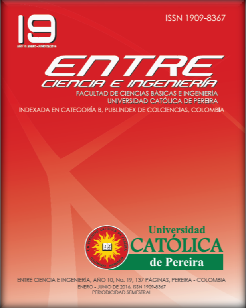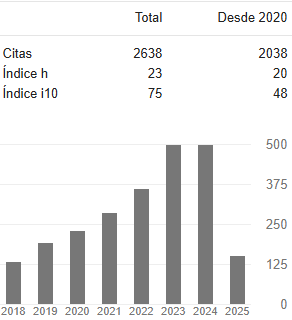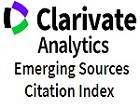Poligonación topográfica de alta precisión en el campus de la Universidad del Quindío
DOI:
https://doi.org/10.31908/19098367.470Palabras clave:
diseño, mediciones topográficas, incertidumbre, instrumentación, poligonación, propagación de erroresResumen
Este trabajo describe el procedimiento de diseño, monumentación y medición de un sistema de poligonación al interior del campus de la Universidad del Quindío, con instrumental clásico, que servirá como marco de referencia para el soporte de los trabajos topográficos y cartográficos de la institución, bajo requisitos técnicos que soporten sus precisiones relativa y absoluta, a través de coordenadas determinadas sobre el sistema de referencia horizontal para Colombia: Datum MAGNA-SIRGAS. La metodología se estructuró bajo la Teoría de Errores, definiendo el límite de las incertidumbres esperadas en función de las características técnicas de los instrumentos de medida, la configuración geométrica del polígono, los métodos y diseños de medición. Se lograron hallazgos interesantes en términos de la propagación del error y sus elipses, debido a que sus magnitudes, formas y orientaciones definieron la dirección de fortalecimiento geométrico del marco de referencia.
Descargas
Referencias
M. J. Sevilla, «Teoría de errores de observación,» Física de la tierra: geodesia marina y geoide, nº 5, pp. 133-166, 1993.
M. A. R. Cooper, Fundamentals of surveying measurements and analysis, London: William Clowes & Sons, 1974, p. 107.
R. Davis y F. Foote, Surveying: Theory and practice, 4th ed., New York: McGraw-Hill Book Company, 1967, p. 880.
S. V. Estopinal, A guide to undestanding land surveys, 2nd ed., United States: John Wiley & Sons, Inc, 1993, p. 226.
R. Márquez, Introducción al ajuste y diseño de redes topográficas, San Juan: Universidad Nacional de San Juan, 2009, p. 180.
N. Ballesteros, Topografía, 1a ed., México, D.F.: Limusa, 1984, p. 474.
B. A. Barry, Errors in practical measurments in surveying, engineering, and technology, M. D. Morris, Ed., United States of America: Landmark Enterprises, 1991, p. 183.
A. Bannister, S. Raymond y R. Baker, Técnicas modernas en topografía, 7a ed., México, D.F.: Alfaomega, 2002, p. 550.
O. Trutmann, The theodolite and its application, Heerbrugg, Switzerland: Wild Heerbrugg, 1967, p. 110.
R. B. Buckner, «The Nature of Measurement: Part 3: Dealing With Errors,» Professional Surveyor Magazine, pp. 66-86, 1997.
J. Nathanson, M. T. Lanzafama y P. Kissam, Surveying fundamentals and practices, 6th ed., New Jersey: Prentice Hall, 1999, p. 502.
R. B. Bucner, Surveying Measurements and Their Analysis, 3th ed., California: Landmark Enterprises, 1991.
R. Martínez Marín, J. C. Ojeda Manrique, J. A. Sánchez Sobrino, J. G. Relas Ayuga y J. García García, Geodesia y Topografía, 1a ed., Madrid: Bellisco, 2004, p. 329.
J. Nathanson, M. Lanzafama y K. Kissam, Surveying fundamentals and practices, 5th ed., United States of America: Pearson Prentice Hall, 2006, p. 502.
W. Schofield y M. Breach, Engineering Surveying, 6th ed., Oxford: Elsevier, 2007, p. 622.
Fialovszky, L.; Holéczy, G.;, «Surveying instruments and their operational principles,» ISPRS Journal of Photogrammetry and Remote Sensing, vol. 48, nº 4, pp. 41-42, 1991.
J. M. Anderson y E. D. Mikhail, Survey: Theory and practice, 7th ed., New York: McGraw-Hill, 1998.
R. Brinker y W. Taylor, Elementary surveying, United States of America: International Textbook Company, 1969, p. 686.
R. Shiu, S. Kang, J. Han y S. Hsieh, «Modeling Systematic Errors for the Angle Measurement in a Virtual Surveying Instrument,» Journal of Surveying Engineering, vol. 137, nº 3, pp. 81-90, 2011.
GUM, Guía para la expresión de la incertidumbre de medida, publicada por ISO en nombre del BIPM, IEC, IFCC, ILAC, ISO, IUPAC, IUPAP y OIML., 2008.
J. R. Smith, Introduction to Geodesy, 2nd ed., New York: John Wiley & Sons, 1997, p. 224.
F. H. Moffitt y J. D. Bossler, Surveying, 10th ed., United States of America: Addison Wesley Longman, Inc., 1998, p. 738.
C. Ghilani y P. Wolf, Elementary surveying: an introduction to geomatics, 13th ed., New Jersey: Pearson Prentice Hall, 2012, p. 931.
R. G. Bird, EDM traverses, New York: John Willey & Sons, 1989, p. 148.
ICSM, Intergovernmental Committee on Surveying and Mapping. Guideline for Conventional Traverse Surveys: Special Publication 1, 2013.
A. A. Seemkooei, «Comparison of reliability and geometrical strength criteria in geodetic networks,» Journal of Geodesy, vol. 75, nº 4, pp. 227-233, 2001.
C. A. Herubin, Principles of Surveying, 4th ed., Virginia: Reston Publishing Company, 1991, p. 301.
I. De Corral y M. de Villena, Topografía de obras, México D.F.: Alafaomega- Ediciones UPC, 2000, p. 354.
F. Domínguez García-Tejero, Topografía general y aplicada, 13a ed., Madrid: ediciones Mundi-Prensa, 1998, p. 811.
USACE, US Army Corps of Engineers, Structural Deformation Surveying, Washington DC: EM 1110-2-1009, 2002.
M. Ruiz Morales, Nociones de topografia y fotogrametria aerea, España: Editorial Universidad de Granada, 2003.
A. Tapia Gómez, Topografía subterránea, Cataluña: Ediciones UPC, 2005, p. 212.
B. F. Kavanagh, Surveying with construction applications, New Jersey: Pearson Prentice Hall, 2007, p. 681.
A. Amiri-Simkooei, J. Asgari, F. Zangeneh-Nejad y S. Zaminpardaz, «Basic Concepts of Optimization and Design of Geodetic Networks.,» Journal of Surveying Engineering, vol. 138, nº 4, pp. 172-183, 2012.
R. Taton, Topografía Subterránea, Madrid: Paraninfo, 1977, p. 190.
L. Lupa-Dima y L. Filip, «Error propagation of the sizes measured in mine working,» Revista Minelor - Mining Revue, nº 2, pp. 32-34, 2012.
Y. . E. Batista-Legrá y O. Belete-Fuentes, «Consideraciones sobre la exactitud de las redes de levantamiento topográfico,» Minería y geología, vol. 29, nº 3, pp. 56-64, 2013.
IPGH, Pan American Institute of Geography and History. Manual de normas y especificaciones para levantamientos geodésicos de alta precisión en áreas pequeñas, México: Comité de Geodesia IPGH, 1987, p. 51.
A. Del Bianco, Topometría y microgeodesia. Notas de clase, Córdoba: Universidad Nacional de Córdoba, 2001, p. 360.
D. Miranda Barrós, J. R. Rodríguez Pérez y J. C. Alonso, «Instalación de redes microgeodésicas como soporte para la gestión y mantenimiento de sistemas de información geográfica de ámbito municipal,» de Teledetección. Avances y aplicación: VIII Congreso Nacional de Teledetección, Albacete, 1999.
O. Cuadrado, L. Garcia-Asenjo, D. Hernández y A. Nuñez, «PLanificación de redes de control de calidad en procesos cartográficos. El proyecto RGPA en el Principado de Asturias,» de VIII congreso nacional de topografía y cartografía, Madrid, 2004.
M. Farjas Abadía, La Topografía y sus métodos: Principios de investigación, Bilbao: Astrolabio, 2012, p. 500.
E. M. Mikhail y F. Ackerman, Observations and least squares, New York: University Press of America, 1983, p. 497.
G. Gómez Gómez y G. Jiménez Cleves, Topografía analítica, Armenia: Universidad del Quindío, 1994, p. 223.
C. D. Ghilani y P. R. Wolf, Adjustment Computations, 4th ed., New York: John Wiley & Sons, Inc., 2006, p. 611.
E. M. Mikhail y G. Gracie, Analysis & Adjustment of Survey Measurements, New York: Van Nostrand Reinhold, 1981, p. 368.
M. Chueca Pasos, J. Herráez Boquera y J. L. Berné Valero, Tratado de Topografía. Tomo III. Redes topográficas y locales.Microgeodesia., Madrid: Paraninfo, S.A, 1996c, p. 448.
IERS, « International Earth Rotation Service Annual Report,» Dick , Wolfgang R.; Richert, Bernd;, Frankfurt am Main, 2000.
L. Sánchez Rodríguez, H. Drewes y H. Tremel, «Procesamiento de la red GPS básica de Colombia. Marco Geocéntrico Nacional MAGNA,» Revista Cartográfica, vol. 73, pp. 7-24, 2001.
M. Chueca Pasos, J. Herráez Boquera y J. L. Berné Valero, Tratado de Topografía Tomo I. Teoría de errores e instrumentación, Madrid: Paraninfo, S.A, 1996a, p. 522.
A. M. Ruiz Armenteros, J. L. García Balboa, J. L. Mesa Mingorance, J. J. Ruiz Lendínez y M. I. Ramos Galán, «Contribution of instrument centring to the uncertainty of a horizontal angle,» Survey Review, vol. 45, nº 331, pp. 305-314, 2013.
P. Richardus y J. S. Allman, Project Surveying, Amsterdam: NorthHolland Publishing Company, 1966.
M. A. R. Cooper, Modern theodolites and levels, 2 nd ed., Oxford: BSP professional books, 1987.
O. Baykal, T. Ergin, M. Z. Cozkun y E. Turan, «Accuracy of Point Layout with Polar Coordinates,» Journal of Surveying Engineering, vol. 131, nº 3, pp. 87-93, 2005.
E. D. Arrufat Molina, Instrumentos Topográficos, Valencia: Tirant lo Blanch, 2006, p. 693.
J. L. García Balboa, A. M. Ruiz Armenteros y J. L. Mesa Mingorance, «Evaluación de la incertidumbre de medidas en ángulos, distancias y desniveles medidos con instrumentación topográfica,» Mapping interactivo, 21 Septiembre 2011.
R. E. Deakin, «A review of Least Squares theory applied to traverse adjustment,» Australian Surveyor, vol. 36, nº 3, pp. 245-253, 1991.
Descargas
Publicado
Número
Sección
Licencia
Derechos de autor 2019 Entre Ciencia e Ingeniería

Esta obra está bajo una licencia internacional Creative Commons Atribución-NoComercial 4.0.



















